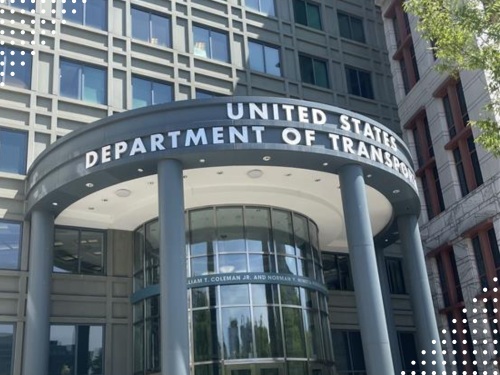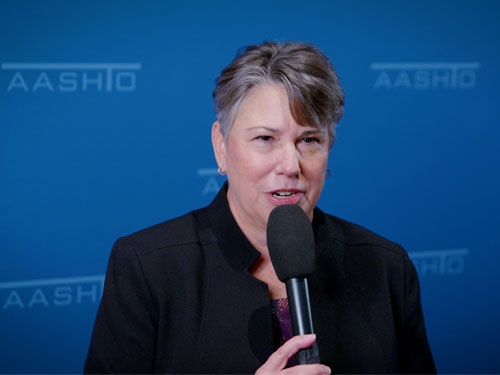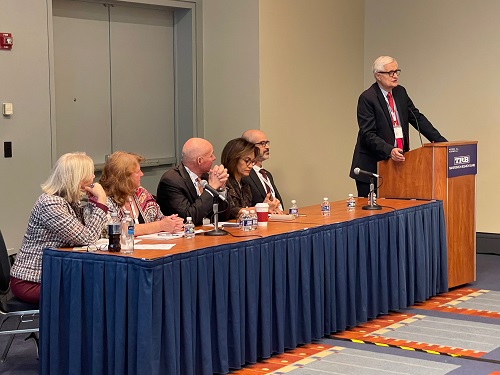Three current and two former state transportation agency executives shared their thoughts on how to use data and information gleaned from a number of sources to make more effective decisions during a roundtable discussion at the 2023 Transportation Research Board Annual Meeting.
[Above photo by AASHTO]
Neil Pedersen, TRB’s former executive director, moderated the panel, which included Carlos Braceras, executive director of the Utah Department of Transportation; Tracy Larkin Thomason, recently named director of the Nevada Department of Transportation; Marc Williams, executive director of the Texas Department of Transportation; Julie Lorenz, former secretary of the Kansas Department of Transportation (who recently joined consulting firm 1898 & Co. as principle consultant); and Yassmin Gramian, at the time the secretary of the Pennsylvania Department of Transportation.

“The reliability, objectivity, replicability, and integrity of data sources is absolutely critical in transportation,” explained Pedersen in his opening remarks at the roundtable. “I can vouch for that criticality based on my 30 years of transportation experience – especially when testifying before legislators,” he added. Pedersen’s career includes 29 years at the Maryland Department of Transportation, the last eight of those spent as State Highway Administrator and the Governor’s Highway Safety Representative.
“Communication of data is also just as important as the role data plays in the project,” he said. “Also remember two things: Data needs to be presented to audiences in understandable ways and that nothing destroys trust more than faulty data.”
Pedersen presented the panel with a range of transportation scenarios where data could provide critical insights for decision making – such as when allocating funds for rail crossing safety improvements or managing response and recovery efforts following severe weather events.

Utah DOT’s Braceras noted that data must be factored into the “larger picture” of what a particular transportation project is trying to accomplish for a community as well as the state.
“Projects generate a lot of data from a lot of sources – and managing the facts in a highly-charged political and social environment is so much harder than used to be,” he stressed. “Conversations have to be based in data, which in turn must be developed in the real world. It is also amazing how much the public will trust private companies with their personal data versus a government agency. And without trust we, as a state DOT, cannot do anything –and such trust takes years to build. Screw up once, and you will have to start over.”
That is where data can play a valuable role for a state DOT in its interaction with the public, Braceras said. “Speak to the facts, not to the fight, when it comes to each project,” he explained. “How we treat people during the decision-making process is key and data can make that process easier for everyone.”

One role data plays in public outreach is in explaining key project benefits, noted Nevada DOT’s Larkin Thomason. “For example, look at all jobs a distribution business can bring in,” she said. Data also helps establish transportation realities on the ground in public discussions. “Often in rural areas, there is no alternative to a state highway for meeting transportation needs,” Larkin Thomason said. “You need to be prepared to explain that.”
Data also helps establish what the broader transportation impact of a particular project might be, noted TxDOT’s Williams.
“It helps [to] identify the specific impact of a project on, say, adjacent roadways – and that may come into the calculus positively or negatively,” he explained. “[Data] creates a picture of where people live, work, shop, and go to school. Data helps you understand how a community works; and that gives you different perspective on potential alternatives. But it requires a deliberate and comprehensive data analysis that touches on many different areas, not always from a strictly engineering perspective.”

PennDOT’s Gramian echoed Williams’ point, emphasizing that transportation project data needs today often go well beyond purely engineering factors.
“Data helps create a central plan to identify the groups that are going to be engaged in a project,” she said. “It helps identify how a project could impact the health of residents, how it impacts noise level. Yet data can also can help communicate safety improvements more effectively to residents as well.
Using data to illustrate the community benefits of a transportation project has become a key attribute today, Kansas DOT’s Lorenz noted – especially in terms of adjustments necessary to accommodate usage patterns.
“It can help simplify the closure process for bridges and understand [travel] patterns in order to ‘right size’ your bridge inventory,” she explained. “But you must be transparent when it comes to data – say what you know and don’t know. The building blocks for your project decisions is data; use it to construct a story – a bit-by-bit narrative, based on experienced – so the delivery of a project decision that can be supported to the public.”
Lorenz also pointed that many types of data get involved with transportation projects: system data, user data, emergency situation data, and finally community-use data. “Remember, too, that data does not get you out of a process hole,” she stressed. “Make sure data helps you tell the story – what is at stake, what happens if no action is taken. Tell it in human terms and tell what matters.”
 Top Stories
Top Stories
USDOT Makes $1.5B Worth of BUILD Grants Available
December 19, 2025 Top Stories
Top Stories

